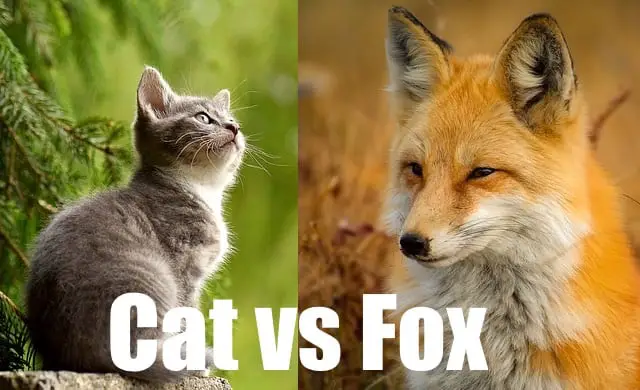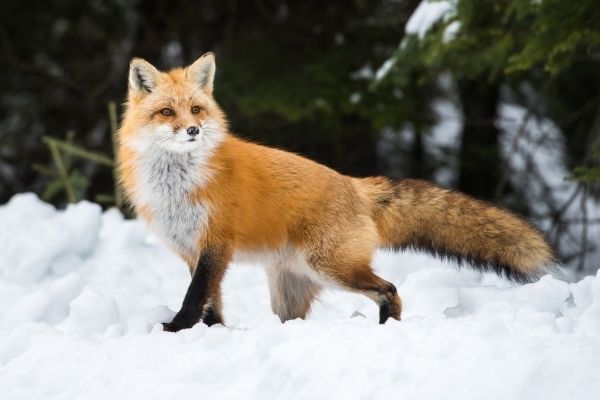Arctic Fox is the hunter and scavenger of the north. It can survive in the extreme cold of the Arctic region. We have researched a complete collection of Arctic Fox Facts For Kids that will help you in learning all about the Arctic Fox such as its scientific name and classification, evolution, features, species, appearance, size, speed, jump, sound, habitat, domestication, migration, hibernation, lifespan, diet, prey, hunting, food chain, reproduction, baby fox, adaptations, predators, endangerment, importance, population and many other interesting facts about Arctic Fox.
Arctic Fox Facts For Kids
1. What Is An Arctic Fox – Arctic Fox Definition
- The Arctic fox is a small fox species indigenous to the Arctic regions of the Northern Hemisphere.
- It is also known as snow fox, polar fox, or white fox.
- It is commonly found all over the Arctic tundra biome.
- It is well adapted to survive in the cold Arctic environment.
- It is well-known for its warm, thick, and white fur, which also provides camouflage.
- The Arctic fox is primarily a carnivore and eats the flesh of other small animals as well as berries and seaweeds.

2. Arctic Fox Scientific Name
- The scientific name of the Arctic fox is Vulpes lagopus.
3. Arctic Fox Classification – Arctic Fox Taxonomy
- The following is the scientific classification or taxonomy of the Arctic fox:
| Kingdom | Animalia |
| Phylum | Chordata |
| Sub-phylum | Vertebrata |
| Class | Mammalia |
| Order | Carnivora |
| Family | Canidae |
| Genus | Vulpus |
| Species | V. lagopus |
| Binomial name | Vulpus lagopus |
4. Arctic Fox Evolution
- It was believed that Arctic foxes evolved in Europe around 2.6 million years ago.
- However, fossil evidence of the extinct precursor Arctic fox (Vulpes qiuzhudingi) was found on the Tibetan Plateau, which belongs to the early Pliocene (5.08 to 3.6 million years ago).
- This ancient fox (Vulpes qiuzhudingi) is now believed as the ancestor of the existing Arctic fox.
- Based on stable carbon and oxygen analysis of the fossils, researchers claim that during the Pliocene, the Tibetan Plateau experienced tundra-like conditions and was home to the cold-adapted mammals.
- These mammals spread later to Eurasia and North America during the Pleistocene (2.6 million to 11,700 years ago).
5. Arctic Fox Characteristics – Arctic Fox Features
- The Arctic fox has a grey-brown to the bluish-brown color of fur in the summer while white color in the winter.
- It inhabits the tundra biome of the Arctic region.
- It is an incredibly robust animal that can endure the hard Arctic environment.
- It has a short muzzle, short ears, and furry soles that reduces heat loss from their body.
- The Arctic fox has generally a round body shape which helps it to reduce heat loss from the body.
- It usually forms monogamous pairs during the reproductive season and both mates raise their young together.
6. Arctic Fox Species
- The Arctic fox is a species of the genus Vulpus, the members of which are referred to as true foxes.
- Four subspecies are described for the arctic fox (Vulpes lagopus), which are:
-
- Bering Island Arctic fox (Vulpes lagopus beringensis)
- Greenland Arctic fox (Vulpes lagopus foragoapusis)
- Iceland Arctic fox (Vulpes lagopus fuliginosus)
- Pribilof Islands Arctic fox (Vulpes lagopus pribilofensis)
7. What Do Arctic Foxes Look Like – Arctic Fox Appearance
- The Arctic fox is a medium-sized mammal with an average body length of 22 inches.
- It has an about 13 inches long tail that is densely covered with thick fur.
- The body of the Arctic fox is stocky and muscular with a good supply of fats.
- It looks like a red fox but has a relatively smaller size, white fur in the winter and grey-brown to blue-brown in the summer.
- An Arctic fox has a short muzzle, small ears, and small eyes.
- It has strong legs while its paws have footpads, which are covered with fur.
8. Arctic Fox Description – Arctic Fox Physical Description
How Big Is An Arctic Fox – Arctic Fox Size
- The average head and body size of a male Arctic fox is up to 22 inches (1.8 feet).
- The typical size range of a male individual is from 18 to 26.75 inches (1.5 to 2.3 feet).
- The average size of a female is 20 inches (1.67 feet). The usual size range of a female individual is from 16 to 22 inches (1.4 to 1.8 feet).
- The length of their tail is up to 13.75 inches (1.14 feet) in both males and females.
How Tall Is An Arctic Fox – Arctic Fox Height
- The height of an adult Arctic fox at the shoulders is from 25 to 30 cm (9.8 to 11.8 inches).
How Much Does An Arctic Fox Weigh – Arctic Fox Weight
- The weight of an adult male Arctic fox ranges from 3.0 to 7.7 kg (6.5 to 17.0 pounds), with an average of 3.5 kg (7.7 pounds).
- While the weight of an adult female ranges from 1.4 to 3.2 kg (3.0 to 7.0 pounds), with an average weight of 2.9 kg (6.4 pounds).
What Color Is An Arctic Fox – Arctic Fox Color
- An Arctic fox has grey-brown to blue-brown fur color in the summer.
- While in winter, it has creamy white fur color, which blends in with the snow.
Blue Arctic Fox
- There are two distinct genetic morphs of the Arctic fox, that is blue and white.
- The blue morph does not change its fur color with the season and usually has blue, brown, or grey fur color throughout the year.
- The blue morph is the dominant allele while the white morph is recessive, but interestingly, white Arctic foxes are 99% of the total population.
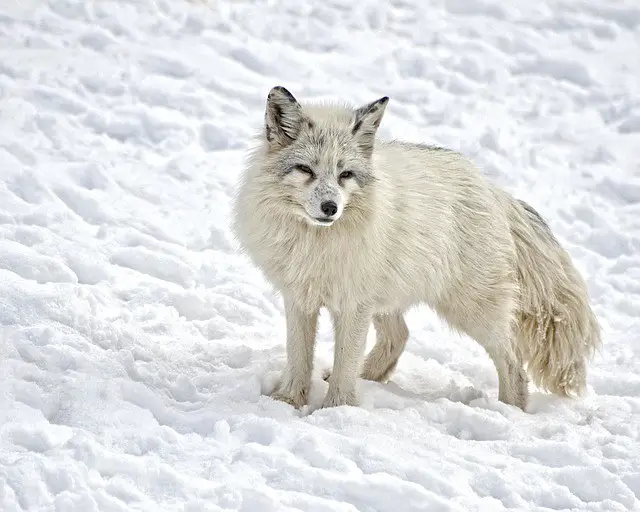
9. How Fast Can An Arctic Fox Run – Arctic Fox Speed
- Arctic foxes can run at the speed of 48 km/h (30 mph).
10. Do Arctic Foxes Swim – Arctic Fox Swimming
- Yes, Arctic foxes can swim.
11. Arctic Fox Jump
- Arctic foxes jump in the air usually to punches through the snow to catch prey.
- They can jump more than 2 feet high in the air.
12. What Sound Does An Arctic Fox Make – Arctic Fox Sound
- Arctic foxes make certain types of sounds.
- To communicate from a long distance in the danger, they make a loud yowl or high pitch sounds.
- Like other foxes, Arctic foxes also scream at night usually to claim their territory.
13. Where Do Arctic Fox Live – Arctic Fox Habitat
- Arctic foxes are indigenous to the Arctic regions of the Northern Hemisphere.
- They inhabit the Arctic tundra biome. Tundra is a biome where low temperature leads to a short growing season and hinders the growth of the trees. The Arctic tundra occurs in the far north of the taiga belt in the far Northern Hemisphere.
- They are found at altitudes of up to 9,800 feet (3,000 meters) above sea level.
- They have been observed on the sea ice near the North Pole.

What Is The Arctic Foxes Habitat – Arctic Fox Habitat Facts
- Arctic foxes inhabit the tundra habitat of the Arctic regions and are found nowhere else in the world.
- They have circumpolar distribution over the Arctic tundra habitats of northern Europe, northern Asia, and North America.
- In North America, their range includes Alaska and Canada as far as Hudson Bay.
- In Asia, they inhabit northern Russia.
- In Europe, their range includes Greenland, Iceland, Fennoscandia, Svalbard, Jan Mayen, and islands in the Barent Sea.
- They are also found in the Bering Sea islands.
- Arctic foxes mostly live in the tundra and pack ice, but are also found in the boreal forests (also known as snow forests or taiga) in Canada and the Kenai Peninsula in Alaska.
Arctic Fox Habitat Map

Arctic Fox Europe
- In Europe, the Arctic fox occurs in the far north Arctic regions.
- Its range includes Greenland, Iceland, Fennoscandian Peninsula (composed of Scandinavia and Kola peninsula, Finland, and Karelia), Svalbard, Jan Mayen, and islands in the Barent Sea.
14. Domesticated Arctic Fox
- Arctic foxes are not commonly domesticated or kept as a pet.
- The reason is that they are well adapted to the Arctic life and maybe easily overheated than other fox species.
- They are also extremely sensitive to hot temperatures and it would be extremely necessary to constantly keep them cool.
15. Do Arctic Foxes Migrate – Arctic Fox Migration
- Most of the Arctic foxes use commuting trips within their home range during the winter season.
- Commuting trips occur between 0 to 2.9 times per month, while a trip lasts less than 3 days.
- Commuting trips are observed in 95.5% of Arctic foxes, while 3.4% are found to be nomadic, and around 1.1% do loop migration (travel to a new range and then come back to its home range).
- Males and females typically travel the same distances for about the same duration.
- Arctic foxes living in the coastal regions near the goose colonies are less likely to migrate, while those living inland and experiencing low-density of lemming populations are more likely to migrate.
- Populations of the Arctic foxes are commonly resident and maintain their territories.
- The Norwegian Polar Institute reported a story in July 2019, in which a GPS tracking device was fitted in a year old female. She was then released on the eastern coast of Spitsbergen in the Svalbard archipelago. The GPS data revealed that the young Arctic fox crossed the polar ice from Norway to Greenland (a distance of 940 miles or 1,512 km) only in 21 days. She then traveled to Ellesmere Island in northern Canada and traveled a total distance of 2,179 miles (3,506 km) in the duration of 76 days before her GPS tracker stopped working. She covered an average distance of 29 miles (46 km) per day and managed to travel as much as 96 miles (155 km) only in a single day.
16. Do Arctic Foxes Hibernate – Arctic Fox Hibernation
- Arctic foxes do not hibernate. However, they reduce their moving activities in the winter season to conserve energy.
- In winter, they also reduce their BMR (Basal Metabolic Rate) through metabolic depression to minimize energy requirements and conserve fat storage.
- They also sometimes bury themselves in the snow for protection.
17. How Long Do Arctic Foxes Live – Arctic Fox Lifespan – Arctic Fox Age
- The average lifespan of an Arctic fox in the wild is 3 to 6 years.
- In the wild, baby Arctic foxes are extremely vulnerable and most of them do not survive till their first birthday.
Arctic Fox Lifespan In Wild
- In the wild, Arctic foxes live for an average age of 3 to 6 years.
- Some individuals live for a maximum and exceptional age of about 11 years.
Arctic Fox Lifespan In Captivity
- Like most other animals, Arctic foxes also live longer in captivity due to good care, proper diet, and protection from natural threats and diseases.
- Their lifespan in captivity is up to 14 years.
18. What Do Arctic Foxes Eat – Arctic Fox Diet Facts
- Arctic foxes are primarily carnivores and eat small animals, such as rodents, hares, birds, fish, as well as eggs, and carrion.
- However, they also eat berries and seaweeds due to which they are considered omnivores.
- They also scavenge the leftover carcasses by large carnivore predators, such as polar bears and wolves.
- In case of food scarcity, they will also eat the droppings of polar bears and wolves.
- Their most common prey is a lemming, and a family of Arctic fox eats dozens of lemmings every day.
- In some regions of northern Canada, a large number of seasonally migrating birds serve as an important food source for Arctic foxes.
- Seabirds are also their major diet in the coastal regions of Iceland and other islands.
- They also prey on the pups of ringed seals during April and May, when the young seals are only confined to their dens under the snow.
- The Arctic fox is also an important predator of the birds’ eggs and eats the eggs of all birds except the large species of the tundra birds.
Arctic Fox Food Source
- The food sources of Arctic foxes are:
- Lemmings, voles, and other rodents found in their habitat
- Hares
- Birds
- Eggs of the birds
- Pups of ringed seals
- Carrion
- Carcasses
- Barries and seaweeds
- Feces of polar bears and wolves (in case of food scarcity)
Arctic Fox Eating Habits
- An arctic fox eats a lot of food when food is abundant to store body fat.
- Arctic foxes also bury the surplus food (caches) as a reserve when food is overabundant.
- During the harsh winter, they eat the stored food or utilize energy from the body fat to survive.
- In Canada, Arctic foxes can obtain goose eggs at a rate of 2.7 to 7.3 eggs per hour, and they store about 80 to 97% of them.
- Analysis of their droppings provides evidence that they consume cached eggs during the winter.
19. What Are Arctic Foxes Prey – Arctic Fox Prey
- The following are the major prey of the Arctic foxes:
- Lemmings
- Voles
- Hares
- Birds
- Fish
- Ringed seal pups
- Other rodents found in their habitat
- Eggs of the birds
20. How Do Arctic Foxes Hunt – Arctic Foxes Hunting
- Arctic foxes use their sensitive senses of smell and hearing to locate their prey.
- They can hear and detect lemmings burrowing about 4 to 5 inches under the snow.
- They can also detect a pup seal in its subnivean den under 59 inches of snow.
- Once Arctic foxes locate their prey, they either dig the snow or jump in the air and then punch through the snow to capture their prey.
Arctic Fox Hunting In Snow
- An Arctic fox walks along the snow to locate its prey.
- Its sensitive hearing system allows it to easily hear the lemmings burrowing about 4 to 5 inches under the snow.
- After locating the prey, it either digs the snow or jumps in the air and punches through the snow to catch the prey.
21. Arctic Fox Food Chain
- The following is the food chain of Arctic fox:
-
Decomposer
- In the food chain of Arctic fox, bacteria and fungi are the decomposers.
-
-
-
Producer
-
-
-
- Arctic mosses (or Calliegon gigantium), Arctic willow, and bearberry, and lichens are the producers.
-
-
-
Primary Consumer
- Lemmings and other rodents are the primary consumers.
-
Secondary Consumer
-
-
-
- The Arctic fox is the secondary consumer and eats lemmings and other rodents.
-
-
-
Tertiary Consumer
-
-
-
- Polar bears and wolves are the tertiary consumers and are the predators of the Arctic foxes.
-
Arctic Fox Food Web
- The following diagram shows the food web of Arctic fox:
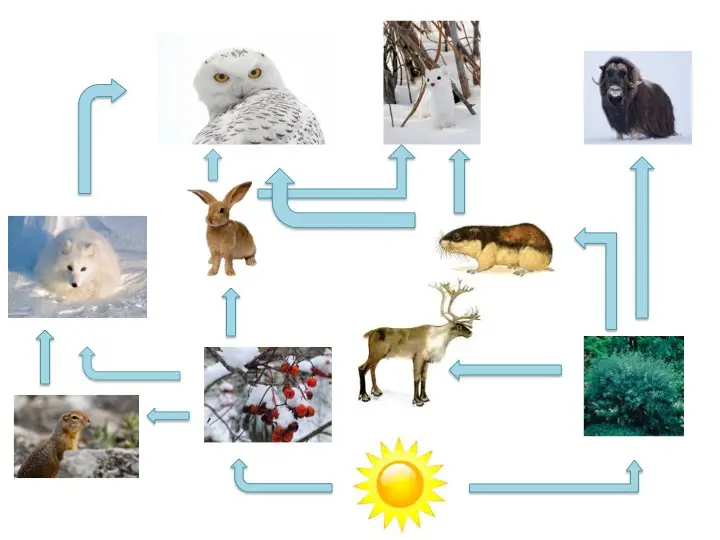
22. Arctic Fox Reproduction
- Arctic foxes usually breed in April and May.
- They reproduce in dens. They select those dens which are easily accessible, have many entrances, and are clean from ice and snow to easily burrow in.
- Forgiving birth, they usually found their dens on rugged terrain to keep their youngs more secure.
- Their gestation period lasts for about 52 days.
- Arctic foxes usually give birth to a litter of 6 to 12 pups. However, a litter may have as many as 25 pups.
- The Arctic fox is primarily monogamous and mates for life.
- Both the parents also take care of their young.
- The pups are usually weaned after 2.5 months of their birth.
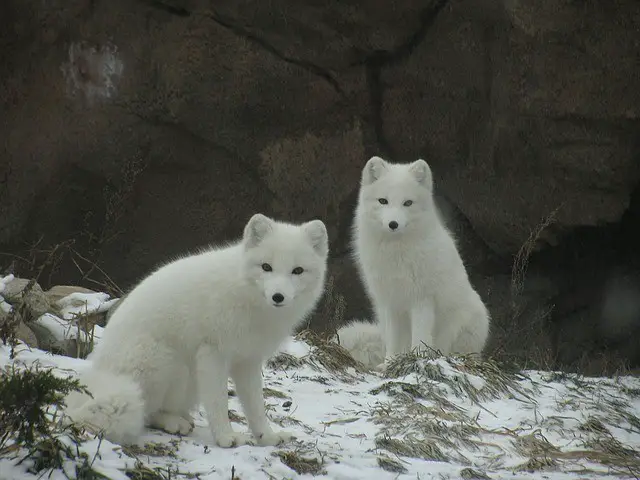
23. Baby Arctic Fox
- A baby Arctic fox is known as a pup or kit.
- The pup or kit is born along with its many sisters and brothers in the form of litter.
- A pup is born deaf, blind, and toothless.
- Each newborn weighs up to 57g.
- Mother feeds all the pups with her milk.
- Both the parents take care of pups and protect them from predators.
- A pup will stay for 3 to 4 weeks in the den after which it starts to emerge.
- It is weaned at the age of 9 weeks.
- A pup becomes sexually mature at the age of 9 to 10 months.
- The pups have low survival rates and most of them do not survive till their first birthday.
- A young Arctic fox will stay within its parents’ territory till the age of one year even in the absence of predators.
White Fox Puppy
- A pup or kit of Arctic fox or white fox is also known as a white fox puppy.
24. Arctic Fox Adaptations Facts – Snow Fox Adaptations
Arctic Fox Behavior – Arctic Fox Behavioral Adaptations
- An Arctic fox suffers a temperature difference of up to 160 to 180℉ (90 to 100℃) between its internal core temperature and the external temperature of the environment.
- To prevent heat loss, an Arctic fox tightly curls up its body, wraps up its furry tail around its body, and tuck its legs and head behind its body and tail. Through this position, the fox attains the smallest surface area to volume ratio as well as protects the less insulated parts of the body.
- To get warm, an arctic fox also avoids winds and resides under its den.
- In the blizzard, the Arctic fox digs deep burrows in the snow to get hidden and stay warm.
- An Arctic fox does not hibernate and stays active throughout the year, however, it reduces its locomotory activities as an attempt to preserve fat.
- During the autumn season, an Arctic fox builds up its fat reservoir and sometimes increases its body weight by more than 50%. Large amounts of body fat provide insulation as well as an energy source in case of food scarcity.
Arctic Fox Adaptations In The Tundra
- The following are some adaptations that help the Arctic fox to survive in the harsh tundra biome:
-
- Low surface area to volume ratio
- Thick and dense fur
- Compact body shape
- Short muzzle
- Short legs
- Short and thick years
Arctic Fox Structural Adaptations – Arctic Fox Physical Adaptations
- The following are the major adaptations of Arctic fox:
-
Fur
- An Arctic fox has dense, multilayered fur that provides excellent insulation.
- In the summer, it has less dense and grey-brown to blue-brown fur.
- In winter, its fur becomes white like snow and up to 140% thicker and denser as compared to that of the summer.
- The Arctic fox has the best insulating fur of all the mammalians.
-
Sense of hearing
- As compared to a dog and kit fox, an Arctic fox has a less sensitive hearing sense.
- The functional hearing range of an Arctic fox is between 125 Hz to 16 kHz with about ≤ 60 dB (Decibel) sensitivity in the air.
- It can easily hear and detect the lemmings that are burrowing 4 to 5 inches under the snow.
- Once it detects and locates its prey, it leaps in the air and then swoops through the snow to capture its prey.
-
Sense of smell
- Arctic foxes have an excellent sense of smell.
- They can smell the abandoned carcasses by polar bears anywhere from a distance of 10 to 40 km.
- They may also track down polar bears through their sense of smell.
- They can smell and locate frozen lemmings under 18 to 30 inches of deep snow.
- They can also detect the lairs of seals under 59 inches of snow at the subnivean zone (a zone between the bottom of the snowpack and the surface of the ground).
-
Special Physiology
- An Arctic fox has some powerful genes that help it to overcome periods of starvation and extreme cold.
- In the winter, Arctic foxes lower their BMR (Basal Metabolic Rate) through metabolic depression to conserve fat storage and reduce their energy requirements.
- In the winter, they lower their average mass-specific BMR to 37% as compared to summer. While their total BMR becomes lower to 27%.
- The most recent data reveals that the Arctic fox’s lower critical temperature in the winter is -7℃ and in the summer is 5℃.
- Like dogs, the Arctic fox also has an evaporative cooling mechanism in its nose, which keeps its brain cool during periods of higher activity and summer.
- Arctic foxes can regulate their body temperature through a countercurrent heat exchange system in the blood of their limbs. They can constantly stand above the tissue freezing surface (-1℃) without losing mobility or feeling pain. They do so based on their ability to increase vasodilation and blood flow to the pad surface, as only their pads have direct contact with the snow, not entire feet. They can selectively constrict blood vessels in the center of their feet pads, which minimize heat loss and conserve energy.
25. Do Arctic Foxes Have Predators
- Yes, Arctic foxes have many predators.
What Are Arctic Foxes Predators – What Eats Arctic Foxes – Arctic Fox Predators
- The major natural predators of the Arctic foxes are:
- Polar bears
- Grizzly bears
- Wolverines
- Wolves
- Red foxes
- Golden eagles
- Snowy owl (primarily prey the kits)
Arctic Fox Enemies
- The natural enemies of the Arctic foxes are polar bears, red foxes, grizzly bears, and golden eagles.
- People also hunt Arctic foxes usually for their fur.
26. Are Arctic Foxes Extinct
- No, Arctic foxes are not extinct.
27. Are Arctic Foxes Endangered – Arctic Fox Endangered
- No, the world population of Arctic foxes is not endangered.
- However, their two subpopulations that are endangered are in the:
-
- Medny Island or Commander Island (Russia)
- Fennoscandia (Kola peninsula, Finland, Sweden, Norway)
Why Are Arctic Foxes Endangered – How Are Arctic Foxes Endangered
- Arctic foxes are not endangered on the IUCN Red List.
- In Medley Island and Fennoscandia, their population is endangered due to several factors.
- In the early years of the 20th century, Arctic foxes were severely hunted for the fur trade in Fennoscandia. It caused a drastic decrease in their population, which is still not recovered. The total population of Arctic foxes in Fennoscandia is only about 140 individuals.
- Diseases are also a threat to their survival. In Medny Island, a skin disease known as ‘Mange’ caused by a parasitic mite is the major reason for Arctic fox’s endangerment.
- While climate change is another threat, which causes the spread of the red fox (Vulpes vulpes) population to their territory in some regions.
Arctic Fox Conservation Status
- The conservation status of Arctic fox on the IUCN Red List is “Least Concern”.
28. Why Are Arctic Foxes Important
- Arctic foxes are important because they keep the population of lemmings and other rodents in control.
- They are itself an important prey for the large carnivore animals found in their habitat region.
- Their presence and thriving is an indicator of the healthy ecological system of the region.
29. Arctic Fox Population
- The exact population of Arctic fox is unknown.
- However, their total population is estimated as several hundred thousand individuals.
30. Arctic Fox Books
- The following are some of the popular books written on the Arctic fox:
- ‘Arctic Fox’ by Katie Marsico
- ‘Arctic Fox: Very Cool!’ By Stephen Person
- ‘Arctic Fox: Life at the Top of the World’ by Garry Hamilton
- ‘The Arctic Fox’ by Mary Ellis
- ‘Arctic Fox’ by Dee Phillips
- ‘A Day in the Life: Polar Animals’ by Katie Marsico
31. Arctic Fox Fun Facts For Kids – Arctic Fox Interesting Facts
- In Iceland, the Arctic fox is the only indigenous land mammal.
- The Arctic fox has the best insulating fur in all mammalians.
- Arctic foxes can regulate the temperature in their paws independently from their core body temperature.
- The coat color of the Arctic foxes indicates where they are most likely to be found. The white form mainly lives inland and blends in with the snow while the blue morph inhabits the coasts and blends in with the rocks and cliffs.
- Migratory Arctic foxes have a 3 times higher mortality rate than resident Arctic foxes.
- Old Arctic foxes commonly show nomadic behavior.
- An Arctic fox can smell the frozen lemmings under 17 to 30 inches of snow.
- They can also smell the carcasses left by wolves or polar bears from a distance of 10 to 40 km.
- Arctic foxes reproduce in dens, which have an extensive system of tunnels. They usually choose the dens that have faces towards the sun to stay warm.
- Arctic foxes are monogamous and most of the mates stay together for life.

